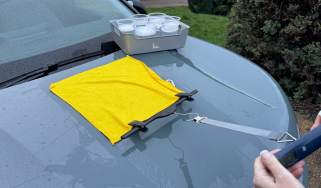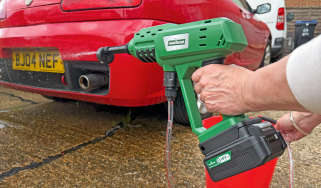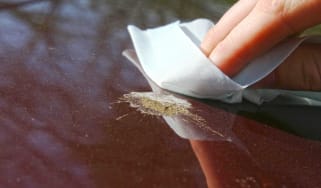Tyre markings and labelling guide: how to read a tyre
Decode your tyre sidewall markings with our straightforward tyre labelling explainer
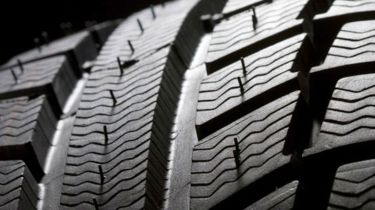
When checking your tyre pressures and tread depth, you’ve probably noticed some numbers, letters and symbols on the sidewall of your tyre. These are known as tyre markings and these details are really useful when it comes to replacing your tyres. While much of the information might be confusing, our tyre markings guide will help you make sense of the tyre codes, speed ratings and tyre labels; helping you make the right decision when it comes to buying a new set of tyres for your car.
When reading the sidewall of a tyre, the first thing you’ll probably notice is the manufacturer and product name, followed by some numbers and letters. These numbers and letters correspond to the width and diameter of the tyre, as well as the maximum speed and load ratings and overall construction.
The rest of the tyre sidewall markings offer more in-depth information, and there’s a lot you can find out from the letters and numbers shown. As well as the vital UK/EU type approval mark, they’ll also tell you when the tyre was manufactured, because unlike fine wine, rubber does not get better with age. You’ll also see stickers that give an indication of efficiency and noise ratings, as well as wet road grip ratings.
How to read a car tyre
There’s a range of information printed on the side of a tyre approved for use on the road. As well as the name of the tyre manufacturer, you’ll also find digits relating to its size and speed rating.
Tyre sizes
On the side of a tyre – also called the sidewall – you’ll find a series of digits. We'll use the following example: 215 45 R16 91 W E4.
The first number – 215 in this example – shows the nominal section width of the tyre in millimetres between the inner and outer sidewall of the tyre.
The second number – 45 – shows the height of the sidewall as a percentage of the tyres' width. In this example, the tyre’s sidewall height is 45% of the 215mm width.
The letter R refers to the tyre’s Radial construction type, which uses steel and kevlar belts to reinforce the tyre carcass and help it maintain its shape at higher speeds. A radial construction is one of the most common types of tyre constructions made by manufacturers, as it helps increase tread life while reducing rolling resistance and fuel consumption. Other tyre construction types include ‘B’ for bias belt and ‘D’ for diagonal belt.
The next number – in this case 16 – refers to the size of the wheel the tyre will fit in inches. So our sample tyre will fit a wheel of 16 inches in diameter.
The number 91 shows the tyre’s load rating, but confusingly this doesn’t relate to the actual weight the tyre is able to carry. In this instance, 91 denotes the ability of the tyre to carry 615kg. Load ratings range incrementally from 62 (265kg) to 126 (1,700kg).
The following letter – W – is the tyre's speed rating. You can find out more about speed ratings in the table below.
The final pair of digits – E4 – is an approval mark showing the tyre has been tested and approved by the European regulatory authorities. You should always check if your tyres carry this approval.
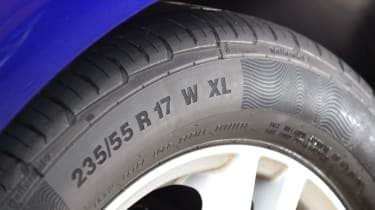
What is a tyre speed rating?
The tyre’s speed rating represents the top speed that the tyre is capable of maintaining and will be illustrated on your tyres sidewall with a single letter (see example above).
It's essential that you choose a tyre capable of travelling at speeds in excess of your car’s maximum speed, even though every tyre is capable of maintaining speeds of more than 70mph.
If you fail to fit a compatible tyre with the correct speed rating, you could find your car insurance invalidated. Driving without valid car insurance could result in you being given a fixed penalty of £300 and six points on your licence should you be caught by the police.
How do I find the correct tyre speed rating for my car?
The tyre speed ratings for your car will be listed in your vehicle’s owner’s manual. Alternatively, check with your main dealer.
Tyre speed rating codes
| Speed rating | Top speed |
| N | 87mph |
| P | 93mph |
| Q | 99mph |
| R | 106mph |
| S | 112mph |
| T | 118mph |
| U | 124mph |
| H | 130mph |
| V | 149mph |
| Z | 150mph+ |
| W | 168mph |
| Y | 186mph |
EV tyre markings
Electric vehicle tyres will have very similar tyre codes to the example provided above, but you might see the letters ‘HL’ at the beginning of the tyre marking. HL indicates that the tyre is capable of handling a higher load index and is suitable for use on an electric car.
Run-flat tyres
Run-flat tyres allow you to drive for up to around 50 miles and a maximum of 50mph if there has been a loss of pressure or a puncture to your tyre. The code on run-flat tyres can vary between manufacturers, but will often be shown as RFT, EMT, ROF, ZP, DSST or SSR.
OE tyre markings
Some tyres are specifically designed for certain car manufacturers. OEM, or Original Equipment Manufacturer, tyre markings are labelled on many tyres to show which car brand a tyre was specifically engineered for. The following table shows which markings correspond to which manufacturers:
| Original Equipment Manufacturer | Sidewall Marking | Explanation |
| Alfa Romeo | AR | Alfa Romeo |
| Aston Martin | AM | Aston Martin |
| Audi | AO | AOE | RO1 | Audi Original | Audi Original Extended (ROF) | Audi Quattro |
| Bentley | B | Bentley |
| BMW | * | “Star” marking |
| BMW & Mercedes | * MO(E) | "Star" marking & Mercedes Original (Extended) |
| Ferrari | K1, K2, K3 | / |
| Jaguar | J | Jaguar |
| Lamborghini | L | Lamborghini |
| Land Rover | LR | Land Rover |
| Jaguar & Land Rover | JLR | Jaguar Land Rover |
| Lotus | LS | Lotus Exige S |
| Maserati | MGT | Maserati Genuine Tires |
| Maserati & Jaguar | MGT J | Maserati Genuine Tires & Jaguar |
| McLaren | MC | Mclaren |
| Mercedes | MOE | MO | MO1 | Mercedes Original Extended (ROF) | Mercedes Original | Mercedes Original (for AMG models) |
| Nissan | NR1 | Nissan GT-R Nismo |
| Porsche | N0, N1, N2, N3, N4, N5, N6 | |
| Tesla | T0, T1, T2,… | Tesla Original |
| Volvo | VOL | Volvo |
New car tyre labelling stickers
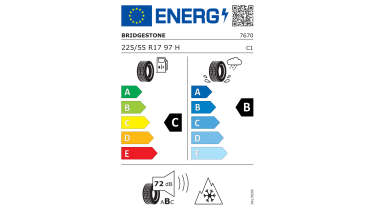
Every new tyre sold in Europe comes with a label that provides information on wet grip, the tyre’s rolling resistance and the noise it generates. An update in 2021 saw the fuel efficiency chart being updated to show overall rolling resistance, as well as the addition of icons for tyres which are suitable for use in severe snow and icy conditions.
The new car tyre labels are designed to look like efficiency stickers you’ll find on consumer white goods with the aim of helping consumers make more informed choices when buying new tyres. Here’s how to decipher the codes:
Rolling resistance
The first chart has a scale of A to E that shows rolling resistance or how much energy is required to turn the wheel. A is the most efficient and E is the least efficient. The difference between grade A and E can be up to 7.5 per cent, according to European Commission research.
Wet grip
The second chart uses the same A-E rating to show the amount of grip the tyre can generate on a wet road. The test used to evaluate wet grip is a braking test from 50mph, and the difference in stopping distance between each grade is around 2.5 metres, or between one and two car lengths.
Therefore, the difference between the stopping distance of an A-rated tyre and an E-rated one could be around 18 metres. If a tyre has a good fuel-efficiency rating, then its wet grip score may be poor, because by reducing rolling resistance, wet grip is reduced, so you’ll need to strike a balance between decent performance in both regards.
Noise
The third chart illustrates the exterior noise generated by the tyre when it's travelling at 50mph. The noise is measured in decibels (dB).
There’s also a symbol that looks a little like a wifi sign. One black arc means the tyre will be compliant with future legal limits, three black arcs represents the weakest performance and sits somewhere between the current maximum and forthcoming lower limits.
Snow icon
The snow icon has been added in the most recent tyre labelling update and simply shows if the tyre is suitable for use in severe snowy conditions. Driving in the snow or during icy conditions can be challenging at the best of times, so these tyres which show the snow icon are highly recommended if you regularly drive in these conditions.
Exceptions
These regulations will apply to most tyres, but some types of tyre for cars, light commercial vehicles and trucks are excluded, including:
• Retreads
• Temporary tyres and space saver spares
• Professional off-road or racing tyres
• Studded tyres – if the metal studs are fitted
• Tyres intended for cars registered before 1 October 1990
• Tyres with a speed rating of less than 50mph
• Tyres with a rim diameter of less than 254mm or more than 635mm
If you're looking for new tyres then why not check out our guide to the best car tyres to buy now...?
Find a car with the experts




